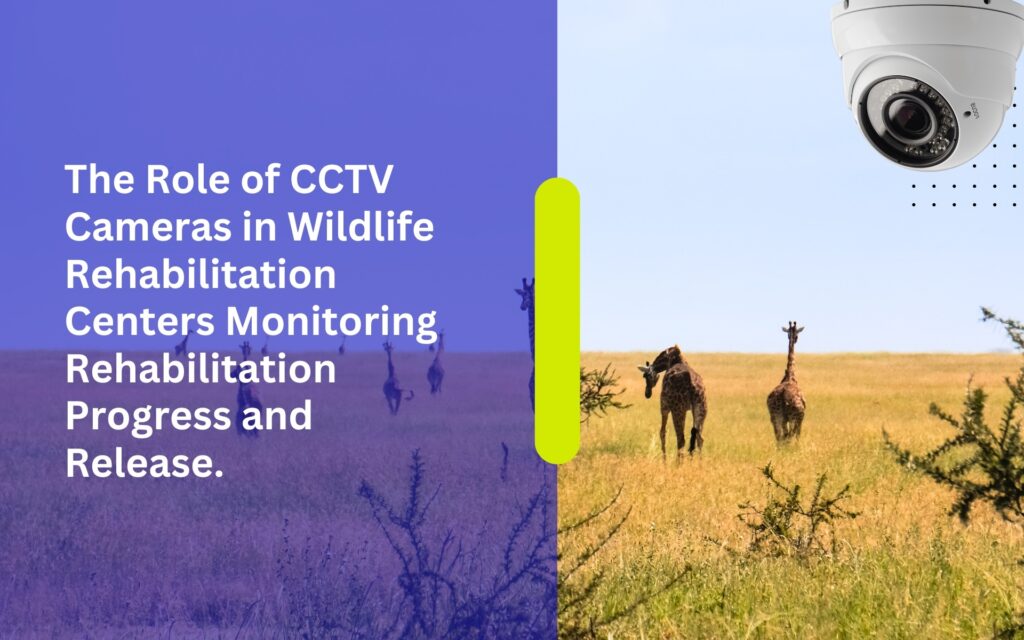CAT 6 Specs Overview. Introduction. In today’s fast-paced digital world, reliable network connectivity is no longer a luxury; it is a fundamental requirement for businesses, educational institutions, and homes. From seamless video …
The Role of CCTV Cameras in Wildlife Rehabilitation Centers Monitoring Rehabilitation Progress and Release.

Introduction
Wildlife rehabilitation centers stand as beacons of hope for injured, orphaned, and distressed animals, offering a haven where they receive care, treatment, and support to ultimately return to their natural habitats. Yet, the journey from rescue to release is fraught with challenges, requiring meticulous monitoring and observation to ensure the successful rehabilitation of wildlife. In recent years, Closed-Circuit Television (CCTV) cameras have emerged as indispensable tools in wildlife rehabilitation centers, providing continuous surveillance and valuable insights into the behavior, health, and progress of the animals under care. This comprehensive article delves into the significance of CCTV cameras in monitoring rehabilitation progress and facilitating the release of wildlife back into the wild.
Understanding Wildlife Rehabilitation
Wildlife rehabilitation encompasses a multifaceted approach to caring for injured, sick, or orphaned wild animals with the goal of restoring their health and readiness for release into their natural environments. These rehabilitation centers serve as sanctuaries where dedicated professionals and volunteers provide medical treatment, nourishment, and behavioral support to facilitate the recovery of a diverse array of wildlife species, ranging from birds and mammals to reptiles and amphibians.
Challenges in Monitoring Wildlife Rehabilitation
Monitoring the progress of wildlife undergoing rehabilitation presents several complex challenges. Firstly, many animals may exhibit stress-related behaviors when in captivity, making it challenging to accurately assess their true recovery progress. Additionally, the individualized care required by each species demands constant vigilance and observation by rehabilitation staff. Furthermore, the ultimate goal of releasing animals back into the wild necessitates ensuring that they retain their natural instincts and behaviors, which can be challenging to evaluate in a controlled environment.
The Role of CCTV Cameras in Wildlife Rehabilitation Centers
CCTV cameras have revolutionized the way wildlife rehabilitation centers monitor and manage their animal populations. These sophisticated surveillance systems provide round-the-clock monitoring, allowing staff to remotely observe animals without causing undue stress or disturbance. The utilization of CCTV cameras offers several key advantages in wildlife rehabilitation:
1. Continuous Monitoring
CCTV cameras enable continuous observation of animals, allowing staff to identify any signs of distress, illness, or abnormal behavior promptly. By maintaining a constant watchful eye, rehabilitation professionals can intervene swiftly to address emerging issues and provide timely assistance to the animals under their care.
2. Behavioral Analysis
One of the most significant benefits of CCTV cameras in wildlife rehabilitation is their ability to facilitate detailed behavioral analysis. By capturing high-definition footage of animals in their enclosures, these cameras provide invaluable insights into the progress of rehabilitation and the readiness of animals for release. Rehabilitation staff can analyze the animals’ interactions, movements, and responses to stimuli, aiding in the assessment of their overall well-being and adjustment to captivity.
3. Remote Observation
Wildlife rehabilitation centers often encompass expansive facilities, making it impractical for staff to monitor all enclosures simultaneously. CCTV cameras address this challenge by enabling remote observation from a central location. Rehabilitation professionals can monitor multiple enclosures simultaneously, improving operational efficiency and reducing the need for extensive on-site staffing.
4. Documentation and Research
The comprehensive footage captured by CCTV cameras serves as a valuable documentation tool for wildlife rehabilitation centers. This video evidence allows staff to track changes in animal behavior, health, and progress over time, facilitating data-driven decision-making and continuous improvement of rehabilitation protocols. Furthermore, researchers can leverage this wealth of footage to study various aspects of animal behavior, stress responses, and rehabilitation success rates, contributing to the advancement of wildlife conservation science.
5. Training and Education
CCTV footage plays a pivotal role in educational initiatives within wildlife rehabilitation centers. By showcasing real-life scenarios captured on camera, these centers can provide valuable learning opportunities for students, volunteers, and the general public. Educational programs and outreach efforts utilize CCTV footage to raise awareness about native wildlife species, conservation challenges, and the importance of wildlife rehabilitation in safeguarding biodiversity.
Case Studies: Successful Implementation of CCTV in Wildlife Rehabilitation
Numerous wildlife rehabilitation centers around the world have successfully integrated CCTV systems into their operations, enhancing their ability to monitor and manage animal populations effectively. These case studies exemplify the diverse applications and benefits of CCTV cameras in wildlife rehabilitation:
1. The Raptor Trust (New Jersey, USA)
Nestled amid the woodlands of New Jersey, The Raptor Trust specializes in the rehabilitation of injured and orphaned birds of prey. The center’s state-of-the-art CCTV system provides continuous surveillance of the raptors housed in its spacious aviaries. Rehabilitation staff utilize the CCTV footage to monitor the birds’ flight capabilities, hunting behavior, and social interactions, enabling them to assess the birds’ readiness for release into the wild accurately.
2. Taronga Wildlife Hospital (Sydney, Australia)
Situated within the iconic Taronga Zoo in Sydney, Australia, Taronga Wildlife Hospital serves as a lifeline for injured and distressed wildlife across the region. The hospital’s comprehensive CCTV network covers a diverse range of native Australian wildlife species, including marsupials, birds, and reptiles. By remotely monitoring the animals’ enclosures, rehabilitation professionals can closely observe their behavior, assess their response to treatment, and make informed decisions regarding their rehabilitation and release.
3. The Wildlife Aid Foundation (Surrey, UK)
Located in the picturesque countryside of Surrey, England, The Wildlife Aid Foundation is renowned for its dedication to the rescue and rehabilitation of British wildlife. The foundation’s extensive CCTV network provides 24/7 surveillance of the orphaned and injured animals housed in its facilities, including foxes, hedgehogs, and birds. Rehabilitation staff rely on the CCTV footage to monitor the animals’ progress, track their recovery milestones, and prepare them for eventual release back into their natural habitats.
Future Directions and Considerations
As technology continues to evolve at a rapid pace, the role of CCTV cameras in wildlife rehabilitation is poised to expand further in the coming years. Several future directions and considerations warrant exploration:
1. Integration of Artificial Intelligence (AI) and Machine Learning
The integration of AI and machine learning algorithms holds immense potential for enhancing the capabilities of CCTV systems in wildlife rehabilitation centers. By leveraging advanced image recognition and behavioral analysis algorithms, these systems can automate the analysis of CCTV footage, enabling more efficient monitoring and early detection of health issues or abnormal behaviors.
2. Enhanced Connectivity and Data Management
Efforts should be made to improve the connectivity and data management capabilities of CCTV systems in wildlife rehabilitation centers. Cloud-based storage solutions, real-time monitoring platforms, and seamless integration with other wildlife management software can streamline data collection, analysis, and decision-making processes, enhancing the overall efficiency and effectiveness of rehabilitation operations.
3. Ethical Considerations and Animal Welfare
While CCTV cameras offer invaluable benefits in monitoring wildlife rehabilitation, ethical considerations and animal welfare must remain paramount. Rehabilitation centers must prioritize the welfare and privacy of the animals under their care, ensuring that CCTV systems are deployed responsibly and ethically. Measures should be implemented to minimize stress and disturbance to the animals, such as strategically positioning cameras, adjusting recording settings, and providing enriching environments.
4. Collaborative Research and Knowledge Sharing
Wildlife rehabilitation centers, researchers, and conservation organizations should engage in collaborative research and knowledge sharing initiatives to maximize the impact of CCTV technology. By sharing insights, best practices, and technological innovations, stakeholders can collectively advance the field of wildlife rehabilitation and contribute to the conservation of biodiversity on a global scale.
Conclusion
In conclusion, the integration of CCTV cameras has revolutionized the field of wildlife rehabilitation, offering unparalleled opportunities for monitoring, observation, and research. These sophisticated surveillance systems provide rehabilitation centers with the tools they need to ensure the well-being of the animals under their care, while also advancing our understanding of wildlife behavior, health, and conservation needs.
By leveraging CCTV technology responsibly and ethically, wildlife rehabilitation centers can enhance their capacity to rehabilitate and release wildlife back into their natural habitats, contributing to the preservation of biodiversity and the protection of endangered species. As we navigate the complex challenges of wildlife conservation in the 21st century, CCTV cameras stand as indispensable allies in our collective efforts to safeguard the natural world for future generations.
Related Articles
Celebrating a Year of Growth and Success at InstallersPH IT Solutions. Introduction. As the year comes to a close, InstallersPH IT Solutions takes a moment to reflect on a journey defined by …
Notice to the Public: Holiday Vacation Advisory of InstallersPH IT Solutions. Introduction. InstallersPH IT Solutions is committed to providing reliable and professional IT services to all our valued clients and partners. As …


